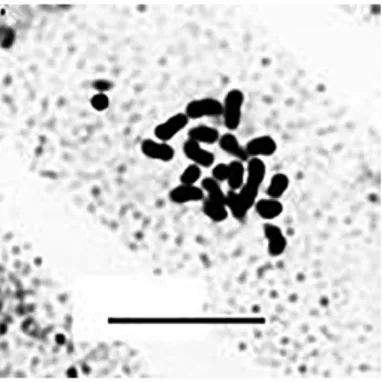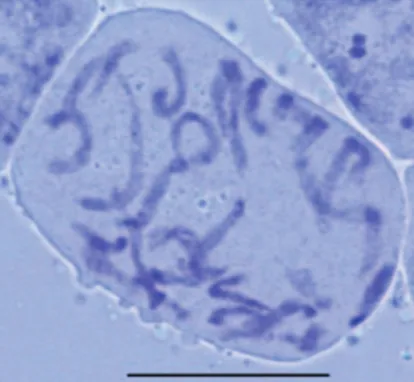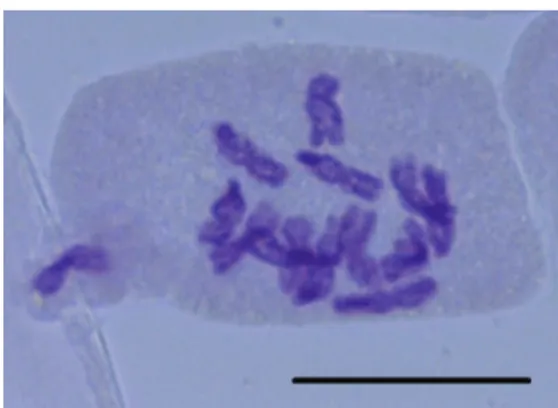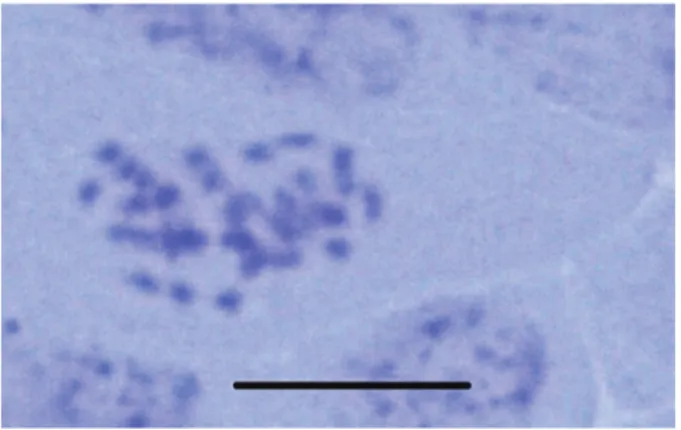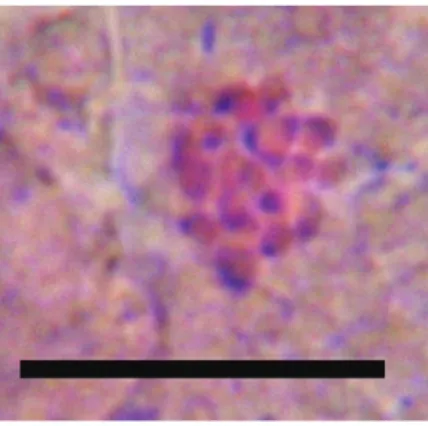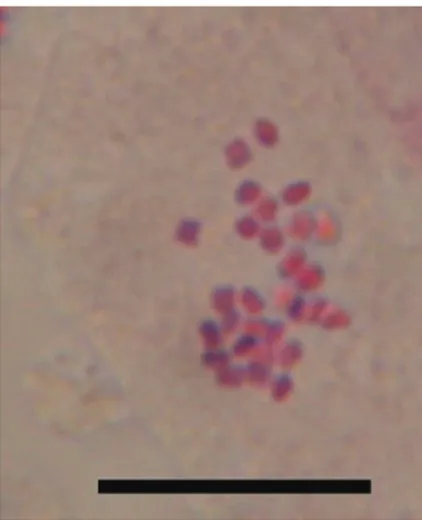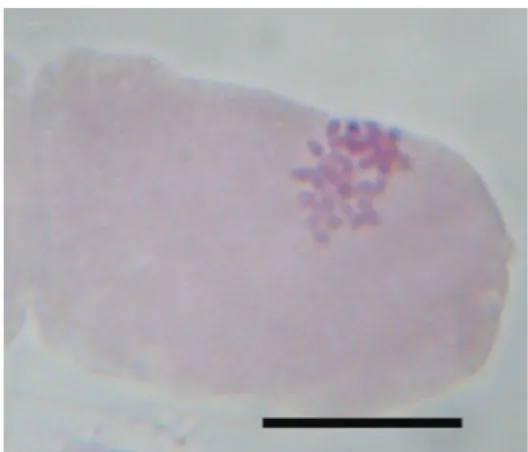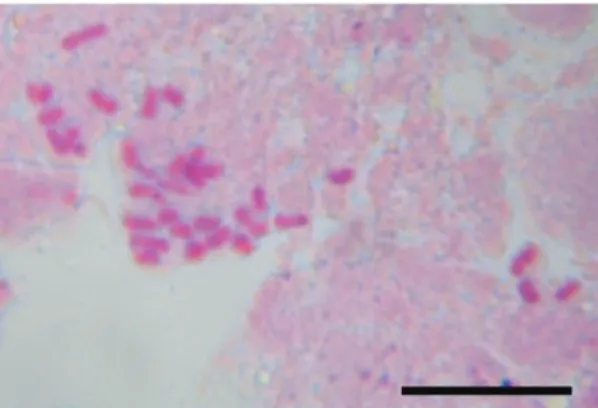1 Dipartimento di Biologia, Università di Pisa, Via Derna 1, 56126 Pisa, Italy 2 Scuola di Bioscienze e
Medicina Veterinaria, Università di Camerino – Centro Ricerche Floristiche dell’Appennino, Parco Nazionale del Gran Sasso e Monti della Laga, San Colombo, 67021 Barisciano (L’Aquila), Italy 3 Via Paolo Mascagni, 27, 50124 Firenze, Italy
Corresponding author: Lorenzo Peruzzi ([email protected])
Academic editor: G. Domina | Received 11 April 2016 | Accepted 13 April 2016 | Published 11 May 2016 Citation: Peruzzi L, Astuti G, Bartolucci F, Conti F, Rizzotto M, Roma-Marzio F (2016) Chromosome numbers for the Italian flora: 1. Italian Botanist 1: 39–53. doi: 10.3897/italianbotanist.1.8818
Abstract
In this contribution new chromosome data obtained on material collected in Italy are presented. It in-cludes 15 chromosome counts for Carduus, Crepis, Picris, Taraxacum (Asteraceae), Ceratonia, Lathyrus (Fabaceae), Colchicum (Colchicaceae), Fritillaria (Liliaceae), Petrorhagia (Caryophyllaceae), Potentilla (Rosaceae), Quercus (Fagaceae), Reseda (Resedaceae), and Thymus (Lamiaceae).
Keywords
Cytogeography, Cytotaxonomy, Karyotype
How to contribute
The text concerning new chromosome data should be submitted electronically to Lorenzo Peruzzi ([email protected]), including indications on voucher specimens and methods used.
Copyright Lorenzo Peruzzi et al. This is an open access article distributed under the terms of the Creative Commons Attribution License (CC BY 4.0), which permits unrestricted use, distribution, and reproduction in any medium, provided the original author and source are credited.
Chromosome counts
Carduus personata (L.) Jacq. subsp. personata (Asteraceae)
Chromosome number. 2n = 20 (Fig. 1)
Voucher specimen. ITALY. Toscana. Alpe della Luna, Appennino Aretino, fag-geta di crinale del M. dei Frati, 1300–1400 m, 12 July 1988, M. Raffaelli, M. Rizzotto,
A. Maury & A. Formelli (FI).
Method. Pretreatment of root tips with 8-hydroxiquinoline for 2 h, fixed in Car-noy, hydrolysis in 1N HCl at 60 °C, stain with 40% orcein.
Observations. Sixteen out of 41 specific and subspecific Carduus taxa growing in Italy are native to Tuscany. Carduus personata is a perennial species occurring in alpine and subalpine areas of central Europe, the Alps, and Carpathian Mountains (Gremaud 1979). It is distributed in northern and central, but not in southern Italy (Conti et al. 2005, Conti and Bartolucci 2013). Several chromosome counts of Carduus species are known from the literature (Gremaud 1979, Peruzzi et al. 2015), with occasional oc-currence of B-chromosomes. Only a few examples of polyploidy have been reported so far (Gremaud 1979). It is the first chromosome count for this species in Italy (Bedini et al. 2010 onwards), and it also represents a new cytotype for the C. personata, for which the following chromosome numbers were reported for other countries so far: 2n = 16, 18, 22 (Rice et al. 2014). The population thriving on the Alpe della Luna oc-curs mostly on moist rocks or in open spots inside the beech forest. Chromosome size ranges from 1.2 to 2.6 μm.
Carduus nutans L. subsp. nutans (Asteraceae)
Chromosome number. 2n = 16 (Fig. 2)
Voucher specimen. ITALY. Toscana. Alpe della Luna, Appennino Aretino da Pian delle Capanne alla Sella, fra M.te Maggiore e M.te dei Frati a 1000–1350 m, 22 August 1989, M. Raffaelli & A. Formelli (FI).
Method. Pre-treatment of root apices with 8-hydroxiquinoline for 2 h, fixed in Carnoy, hydrolysis in 1N HCl at 60 °C, staining with 40% orcein.
Observations. The species Carduus nutans, with six subspecies, is widespread throughout the Italian peninsula (Conti et al. 2005). The chromosome number found in plants from Alpe della Luna is the same as that found in plants from other Italian localities (Favarger 1973, Brullo et al. 1978, Bellomaria and Hruska 1983) and from populations of Eastern Europe (Rice et al. 2014). Chromosome size ranges from 2.6 to 2.8 μm.
Reseda luteola L. (Resedaceae)
Chromosome number. 2n = 26 (Fig. 3)
Voucher specimen. ITALY. Toscana. Alpe della Luna (Appennino Aretino), da Pian delle Capanne salendo al crinale di M.te dei Frati, 17 September 1987, M.
Raf-faelli & A. Formelli (FI).
Method. Pre-treatment of root apices with 8-hydroxiquinoline for 2 h, fixed in Carnoy, hydrolysis in 1N HCl at 60 °C, staining with 40% orcein.
Observations. Reseda luteola is widely distributed all over the Italian peninsula, Sicily and Sardinia (Conti et al. 2005). The population from Alpe della Luna occurs mostly in dry meadows below 1000 m of elevation (Raffaelli and Rizzotto 1991). It is the first chromosome count for this species in Italy (Bedini et al. 2010 onwards). This chromosome number was already reported, as the most frequent, for other countries, together with 2n = 24, 28 (Fernández-Peralta et al. 1982, Rice et al. 2014). Chromo-some size ranges from 1.8 to 3.5 μm.
M. Rizzotto Figure 1. Carduus personata (L.) Jacq. subsp. personata, 2n = 20. Scale bar: 10 μm.
Colchicum bulbocodium Ker Gawl. subsp. versicolor (Ker Gawl.) K.Perss. (Colchicaceae)
Chromosome number. 2n = 22 (Fig. 4)
Voucher specimen. ITALY. Abruzzo. Campo Felice (Lucoli, L’Aquila), pascoli, 1500 m, 19 May 2006, F. Conti & R. Soldati (APP, n. 30130).
Method. Squash preparations were made on root tips obtained from cultivated corms. Root tips were pre-treated with 0.4% colchicine for 3 h and then fixed in Car-noy solution for 1 h. After hydrolysis in 1N HCl at 60 °C, the tips were stained with leuco-basic fuchsin.
Observations. The genus Colchicum L. exhibits a wide range of chromosome numbers and ploidy levels, from 2n = 14 to 2n = ca. 216 (Chacón et al. 2014).
Col-chicum bulbocodium subsp. versicolor is an east European taxon, occurring in Italy only
in Abruzzo, Lazio and Umbria, doubtful in Valle d’Aosta (Conti et al. 2005, Miglio and Santucci 2011, Bovio 2014). It is the first chromosome count for this species in Italy (Bedini et al. 2010 onwards), and it agrees with previous counts made in other countries (Wetschnig 1992, Persson 2009).
Fritillaria montana Hoppe ex W.D.J.Koch (Liliaceae)
Chromosome number. 2n = 18 (Fig. 5)
Voucher specimen. ITALY. Abruzzo. Valle del Giovenco (L’Aquila), May 2008,
F. Bartolucci & V. Impiccini (APP).
Method. Squash preparations were made on root tips obtained from cultivated bulbs. Root tips were pre-treated with 0.4% colchicine for 3 h and then fixed in Car-noy solution for 1 h. After hydrolysis in 1N HCl at 60 °C, the tips were stained with leuco-basic fuchsin.
Observations. The chromosome count found is typical for this species, and was reported for several other localities from Italy and abroad (Bartolucci et al. 2009). Interestingly, 2n = 24 was published for the same population studied here (Chichir-iccò and Tammaro 1982, under the name Fritillaria orsiniana Parl.). Bartolucci et al. (2009) did not have the possibility to study these plants, so that the question was left open. Now, it is evident that the count by Chichiriccò and Tammaro (1982) is errone-ous and/or referred to another taxon.
Lathyrus pannonicus (Jacq.) Garcke (Fabaceae)
Chromosome number. 2n = 14 (Fig. 6)
Voucher specimen. ITALY. Abruzzo. Altopiano delle Rocche, nei pressi di Cam-po di Rovere (Rocca di Mezzo, L’Aquila), 24 May 2006, F. Bartolucci (APP, n. 34710).
Method. Squash preparations were made on root tips obtained from cultivated plants. Root tips were pre-treated with 0.4% colchicine for 3 h and then fixed in
Car-Figure 3. Reseda luteola L., 2n = 26. Scale bar 5 μm.
Figure 4. Colchicum bulbocodium Ker Gawl. subsp. versicolor (Ker Gawl.) K.Perss., 2n = 22. Scale bar:
10 μm.
Figure 5. Fritillaria montana Hoppe ex W.D.J.Koch, 2n = 18. Scale bar: 10 μm.
noy solution for 1 h. After hydrolysis in 1N HCl at 60 °C, the tips were stained with leuco-basic fuchsin.
Observations. According to Schlee et al. (2011), this population (named “Rovere type”), as well as the populations from the National Park of Abruzzo (Conti and Bar-tolucci 2015), shows intermediate morphological traits among different subspecies, so
Figure 6. Lathyrus pannonicus (Jacq.) Garcke, 2n = 14. Scale bar: 10 μm.
that it is not possible to safely attribute it to any currently recognised subspecies. It is the first chromosome count for this species in Italy (Bedini et al. 2010 onwards), and it agrees with previous counts made elsewhere (Rice et al. 2014).
Thymus striatus Vahl subsp. acicularis (Waldst. & Kit.) Ronniger (Lamiaceae)
Chromosome number. 2n = 26 (Fig. 7)
Voucher specimen. ITALY. Abruzzo. Feudo d’Ugni, Parco Nazionale della Ma-jella (Pennapiedimonte, Chieti), 2300 m, F. Conti & F. Bartolucci, August 2011 (APP).
Method. Squash preparations were made on root tips obtained from cultivated plants. Root tips were pre-treated with 0.4% colchicine for 3 h and then fixed in Car-noy solution for 1 h. After hydrolysis in 1N HCl at 60 °C, the tips were stained with leuco-basic fuchsin.
Observations. Thymus straitus s.l. shows several chromosome numbers, i.e. 2n = 26, 28, 42, 54, 56, 84 (Bartolucci and Peruzzi 2014 and literature cited therein). The chromosome number found is typical for this subspecies, and was reported for other localities from central Italy (Bartolucci and Peruzzi 2014).
G. Astuti, F. Roma-Marzio, F. Bartolucci, F. Conti & L. Peruzzi
Ceratonia siliqua L. (Fabaceae)
Chromosome number. 2n = 24 (Fig. 8)
Voucher specimen. ITALY. Puglia. C.da Serranova (Carovigno, Brindisi), nei pressi della masseria Grottamiranda, uliveto misto a Ceratonia siliqua su suolo calcareo con roccia affiorante, 68 m, 11 August 2015, F. Roma-Marzio & G. Roma-Marzio (PI).
Figure 7. Thymus striatus Vahl subsp. acicularis (Waldst. & Kit.) Ronniger, 2n = 26. Scale bar: 5 μm.
Figure 8. Ceratonia siliqua L., 2n = 24. Scale bar: 10 μm.
Method. Squash preparations were made on root tips obtained from germinating seeds. Root tips were pre-treated with 0.4% colchicine for 3 h and then fixed in Car-noy solution for 1 h. After hydrolysis in 1N HCl at 60 °C, the tips were stained with leuco-basic fuchsin.
Observations. Ceratonia siliqua is a Mediterranean species, native to Turkey, Cy-prus, Syria, Lebanon, Palestine, southern Jordan, Egypt, Tunisia, and Libya; some au-thors believe that it was probably introduced to Greece, Italy, France, Spain, and Portu-gal in ancient times (Ballesteros et al. 2015). Conti et al. (2005, 2007), however, report this species as native in all the coastal regions of central-southern Italy, Sardinia, and Sicily. It is the first chromosome count for this species in Italy (Bedini et al. 2010 on-wards), and it agrees with most of the counts made in other countries (Rice et al. 2014), with the exception of two reports (2n = 36, 2n = 48) from Israel (Bureš et al. 2004).
Quercus × pseudosuber Santi (Fagaceae)
Chromosome number. 2n = 24 (Fig. 9)
Voucher specimen. ITALY. Toscana. versante settentrionale del M.te Vitalba, loc. Fontana del Vitalba (Chianni, Pisa), bosco misto su suolo calcareo argilloso, 512 m, 9 December 2015, F. Roma-Marzio & M. D’Antraccoli (PI).
Method. Squash preparations were made on root tips obtained from germinating acorns. Root tips were pre-treated with 0.4% colchicine for 3 h and then fixed in Car-noy solution for 1 h. After hydrolysis in 1N HCl at 60 °C, the tips were stained with leuco-basic fuchsin.
Observations. According to Cristofolini and Crema (2005), the name Q. ×pseudosuber Santi should be exclusively applied to the systematic unit occurring from central Tuscany to southern Italy, whereas plants from northern Italy (including N Apennine) and SE France, should refer to the name Quercus crenata Lam. In our opinion, the two units can be hardly distinguished morphologically. However, according to Peruzzi et al. (2011), the studied population should be referred to Q. ×pseudosuber. It is the second chromosome count for this species in Italy (Bedini et al. 2010 onwards), and it agrees with the report published by D’Emerico et al. (1995, under the name Quercus crenata) for southern Italy.
Quercus robur L. subsp. robur (Fagaceae)
Chromosome number. 2n = 24 (Fig. 10)
Voucher specimen. ITALY. Toscana. Colline delle Cerbaie, loc. Le Pianore (Ca-stelfranco di Sotto, Pisa), margine di bosco mesofilo, 50 m, 21 October 2015, F.
Roma-Marzio & M. D’Antraccoli (absent; acorns collected in the field only).
Method. Squash preparations were made on root tips obtained from germinating acorns. Root tips were pre-treated with 0.4% colchicine for 3 h and then fixed in Car-noy solution for 1 h. After hydrolysis in 1N HCl at 60 °C, the tips were stained with leuco-basic fuchsin.
Observations. It is the first chromosome count for this species in Italy (Bedini et al. 2010 onwards), and it agrees with other counts from abroad (Rice et al. 2014), confirming the high chromosome number stability in the genus Quercus L.
Francesco Roma-Marzio
Crepis rubra L. (Asteraceae)
Chromosome number. 2n = 10 (Fig. 11)
Voucher specimen. ITALY. Campania. Vallone San Nicola (Trevico, Avellino), prato arido, 710–930 m, 4 June 2015, G. Astuti, L. Peruzzi & F. Roma-Marzio (absent; cypselae collected in the field only).
Figure 9. Quercus ×pseudosuber Santi, 2n = 24. Scale bar: 10 μm.
Figure 10. Quercus robur L. subsp. robur, 2n = 24. Scale bar: 10 μm.
Method. Squash preparations were made on root tips obtained from germinating cypselae. Root tips were pre-treated with 0.4% colchicine for 3 h and then fixed in Carnoy solution for 1 h. After hydrolysis in 1N HCl at 60 °C, the tips were stained with leuco-basic fuchsin.
Observations. Crepis rubra is a species with a Mediterranean distribution (Pignatti 1982), occurring in Italy only in Campania, Puglia, Basilicata, and Calabria, doubtful in Molise (Conti et al. 2005). According to a recent taxonomic review of the genus
Crepis L., based on molecular studies, this species (previously classified within C. sect. Hostia (Moench) Babc.) is now placed within C. sect. Barkhausia (Moench) Gaudin,
along with other taxa previously included within C. sect. Zacintha (Mill.) Babc. and C. sect. Berinia (Brign.) Babc. (Enke 2009). It is the first chromosome count for this spe-cies in Italy (Bedini et al. 2010 onwards), and it agrees with most of the counts made abroad, even though other chromosome numbers are also reported: 2n = 8, 2n = 12, and 2n = 16 (Rice et al. 2014).
Petrorhagia dubia (Raf.) G.López & Romo (Caryophyllaceae)
Chromosome number. 2n = 30 (Fig. 12)
Voucher specimen. ITALY. Campania. Vallone San Nicola, Trevico, Avellino, pendio rupestre, 710–930 m, 4 June 2015, G. Astuti, L. Peruzzi & F. Roma-Marzio (PI).
Method. Squash preparations were made on root tips obtained from germinating seeds. Root tips were pre-treated with 0.4% colchicine for 3 h and then fixed in Car-noy solution for 1 h. After hydrolysis in 1N HCl at 60 °C, the tips were stained with leuco-basic fuchsin.
Observations. Petrorhagia dubia belongs to P. sect. Kohlrauschia (Kunth) P.W.Ball & Heywood, which includes annual and self-compatible species characterized by a basic chromosome number x = 15 (Thomas and Murray 1983). Our chromosome number report is the first from peninsular Italy, and it agrees with a previous report from Sicily (Colombo and Trapani 1989, under the name Petrorhagia velutina (Guss.) P.W.Ball & Heywood) and with counts made elsewhere (Thomas and Murray 1983, Diaz Lifante and Parra Martin 2013, Rice et al. 2014).
Picris hieracioides L. subsp. hieracioides (Asteraceae)
Chromosome number. 2n = 10 (Fig. 13)
Voucher specimen. SAN MARINO. San Marino, Monte Titano, sentiero roccio-so roccio-sotto la torre “il montale”, 19 August 2014, D. Dolci (PI).
Method. Squash preparations were made on root tips obtained from germinating cypselae. Root tips were pre-treated with 0.4% colchicine for 3 h and then fixed in Carnoy solution for 1 h. After hydrolysis in 1N HCl at 60 °C, the tips were stained with leuco-basic fuchsin.
Figure 12. Petrorhagia dubia (Raf.) G.López & Romo, 2n = 30. Scale bar: 10 μm.
Figure 13. Picris hieracioides L. subsp. hieracioides, 2n = 10. Scale bar: 10 μm.
Observations. In Italy, the genus Picris L. includes four species and only two subspecies are currently recognized within P. hieracioides (Slovák et al. 2012, Astuti et al. 2015). Our chromosome count agrees with other data from Italy and elsewhere (Slovák et al. 2007, Bedini et al. 2010 onwards, Rice et al. 2014, Astuti et al. 2015).
Potentilla pedata Willd. ex Hornem. (Rosaceae)
Chromosome number. 2n = 28 (Fig. 14)
Voucher specimen. ITALY. Basilicata. versante lucano del Monte Sparviere (Terranova del Pollino, Potenza), pascolo, 1547 m, August 2015, F. Roma-Marzio &
L. Peruzzi (PI).
Method. Squash preparations were made on root tips obtained from germinating seeds. Root tips were pre-treated with 0.4% colchicine for 3 h and then fixed in Carnoy
solution for 1 h. After hydrolysis in 1N HCl at 60 °C, the tips were stained with leuco-basic fuchsin.
Observations. This species was recently recorded for the locality studied by Roma-Marzio et al. (2016), and it is currently reported for most of the Italian regions (Fal-cinelli et al. 2015 and literature cited therein). It is the first chromosome count for this species in Italy (Bedini et al. 2010 onwards), and it agrees with counts made on Hungarian plants (Borhidi 1968, under the name P. pedata var. pseudopedata Borhidi). However, plants from Bulgaria were reported as having 2n = 35, 49, 56 chromosomes (Markova and Goranova 1996).
Taraxacum olivaceum Soest (Asteraceae)
Chromosome number. 2n = 32 (Fig. 15)
Voucher specimen. ITALY. Toscana. Monte Pratofiorito (Bagni di Lucca, Luc-ca), versante N-NE, prato al margine di bosco, 1117 m, 20 May 2015, F.
Roma-Marzio, M. D’Antraccoli, G. Astuti & L. Peruzzi (PI).
Method. Squash preparations were made on root tips obtained from germinating cypselae. Root tips were pre-treated with 0.4% colchicine for 3 h and then fixed in Carnoy solution for 1 h. After hydrolysis in 1N HCl at 60 °C, the tips were stained with leuco-basic fuchsin.
Observations. This species belongs to Taraxacum sect. Palustria (H.Lindb.) Dahl-st. and it was identified according to the multi-access key published by Kirschner and Štěpánek (1998). Our chromosome count is the second one for Italy (Bedini et al. 2010 onwards); it agrees with that published by Aquaro et al. (2010), from Tuscany and with earlier counts made abroad (Kirschner and Štěpánek 1998).
F. Roma-Marzio, G. Astuti & L. Peruzzi
References
Aquaro G, Carlesi V, Giordani A, Peruzzi L (2010) Numeri Cromosomici per la Flora Italiana: 1471–1474. Informatore Botanico Italiano 42(1): 365–366.
Astuti G, Roma-Marzio F, Peruzzi L (2015) The genus Picris (Asteraceae) in southern Italy: contribution to its systematic knowledge. Phytotaxa 207(1): 106–114. doi: 10.11646/phy-totaxa.207.1.5
Ballesteros D, Meloni F, Bacchetta G (Eds) (2015) Manual for the propagation of selected Mediterranean native plant species. Ecoplantmed, ENPI, CBC-MED.
Bartolucci F, Caparelli KF, Peruzzi L (2009) A biometric study of Fritillaria montana Hoppe s.l. (Liliaceae) shows a single polymorphic species, with no infraspecific taxa. Plant Biosystems 143(3): 516–527. doi: 10.1080/11263500902722956
Bartolucci F, Peruzzi L (2014) Thymus paronychioides (Lamiaceae), a neglected species from Sicily belonging to Thymus sect. Hypodromi. Folia Geobotanica 49: 83–106. doi: 10.1007/ s12224-013-9156-2
Bedini G, Garbari F, Peruzzi L (Eds) (2010 onwards) Chrobase.it – Chromosome numbers for the Italian flora. http://bot.biologia.unipi.it/chrobase/index.php [accessed 5 April 2016] Bellomaria B, Hruska K (1983) Numeri Cromosomici per la Flora Italiana: 962–966. Informatore
Botanico Italiano 15(1): 53–57.
Borhidi A (1968) Karyological studies on southeast European plant species. I. Acta Botanica Academiae Scientiarum Hungaricae 14: 253–260.
Bovio M (2014) Flora Vascolare della Valle d’Aosta, repertorio commentato e stato delle cono-scenze. Testolin Editore, 664 pp.
Brullo S, Pavone P, Zizza A (1978) Numeri Cromosomici per la Flora Italiana: 506–516. Infor-matore Botanico Italiano 10(3): 397–465.
Bureš P, Pavlíček T, Horová L, Nevo E (2004) Microgeographic genome size differentiation of the carob tree, Ceratonia siliqua, at ‘Evolution Canyon’, Israel. Annals of Botany 93: 529–535. doi: 10.1093/aob/mch074
Chichiriccò G, Tammaro F (1982) Numeri Cromosomici per la Flora Italiana: 910–918. Infor-matore Botanico Italiano 14(2–3): 264–267.
Colombo P, Trapani S (1989) Numeros cromosomaticos de plantas occidentales, 556–567. Anales del Jardin Botánico de Madrid 47(1): 180–183.
Conti F, Abbate G, Alessandrini A, Blasi C (Eds) (2005) An annotated checklist of the Italian vascular flora. Palombi Editori, Roma, 428 pp.
Conti F, Alessandrini A, Bacchetta G, Banfi E, Barberis G, Bartolucci F, Bernardo L, Bonacquisti S, Bouvet D, Bovio M, Brusa G, Del Guacchio E, Foggi B, Frattini S, Galasso G, Gallo L, Gangale C., Gottschlich G, Grünanger P, Gubellini L, Iiriti G, Lucarini D, Marchetti D, Moraldo B, Peruzzi L, Poldini L, Prosser F, Raffaelli M, Santangelo A, Scassellati E, Scortega-gna S, Selvi F, Soldano A, Tinti D, Ubaldi D, Uzunov D, Vidali M (2007) Integrazioni alla checklist della flora vascolare italiana. Natura Vicentina 10(2006): 5–74.
Conti F, Bartolucci F (2013) Notulae: 1991–1995. In: Barberis G, Nepi C, Peccenini S, Peruzzi L (Eds) Notulae alla checklist della flora vascolare italiana 15. Informatore Botanico Italiano 45(1): 103–105.
Conti F, Bartolucci F (2015) The Vascular Flora of the National Park of Abruzzo, Lazio and Molise (Central Italy), an annotated checklist. Geobotany Studies 6: 1–254.
Cristofolini G, Crema S (2005) A morphometric study of the Quercus crenata species complex (Fagaceae). Botanica Helvetica 115: 155–167. doi: 10.1007/s00035-005-0728-5
D’Emerico S, Bianco P, Medagli P, Schirone B (1995) Karyotype analysis in Quercus spp. (Fagaceae). Silvae Genetica 44(2–3): 66–70.
Diaz Lifante Z, Parra Martin R (2013) Chromosome numbers of plants collected during Iter Mediterraneum V in Morocco. Bocconea 26: 151–172.
Enke N (2009) Contributions towards a revised infrageneric classification of Crepis (Cichorieae, Compositae). Willdenowia 39: 229–245. doi: 10.3372/wi.39.39202
Falcinelli F, Conti F, Donnini D (2015) Contributo alla flora vascolare dell’Umbria (Italia centrale). Natural History Sciences 2(1): 25–30. doi: 10.4081/nhs.2015.213
Favarger C (1973) Cytotaxonomie de quelques Orophytes des Abruzzes. Acta Botanica Academiae Scientiarum Hungaricae 19(1–4): 81–92.
Fernández-Peralta AM, González-Aguilera JJ (1982) Cytogenetic and evolutionary studies on the Spanish species of Reseda L.: section Luteola Dumort. (Resedaceae). Taxon 31: 1–8. doi: 10.2307/1220584
Gremaud M (1979) Nouvelle contribution a la cytotaxonomie du genre Carduus (Compositae). Berichte der Schweizerischen Botanischen Gesellschaft 89: 133–143.
Kirschner J, Štepánek J (1998) A monograph of Taraxacum sect. Palustria. Institute Botany Academy Sciences Czech Republic, Pruhonice, 281 pp.
Markova M, Goranova V (1996) Reports (757–761) In: Kamari G, Felber F, Garbari F (Eds) Mediterranean chromosome number reports – 6. Flora Mediterranea 6: 317–323.
Miglio M, Santucci B (2011) Notula: 1775. In: Barberis G, Nepi C, Peccenini S, Peruzzi L (Eds) Notulae alla checklist della flora vascolare italiana 11. Informatore Botanico Italiano 43(1): 130–131.
Persson K (2009) Colchicaceae. In: Marhold K, Breitwieser I (Ed.) IAPT/IOPB chromosome data 7. Taxon 58(1): 181–183.
Peruzzi L, Astuti G, Carta A, Roma-Marzio F, Dolci D, Caldararo F, Bartolucci F, Bernardo L (2015) Nomenclature, morphometry, karyology and SEM cypselae analysis of Carduus
pennino Aretino, Toscana). Webbia 46(1): 19–79. doi: 10.1080/00837792.1991.10670508 Rice A, Glick L, Abadi S, Einhorn M, Kopelman NM, Salman-Minkov A, Mayzel J, Chay O,
Mayrose I (2014) The Chromosome Counts Database (CCDB) a community resource of plant chromosome numbers. http://ccdb.tau.ac.il/home/ [accessed 5 April 2016]
Roma-Marzio F, Bernardo L, Liguori P, Peruzzi L (2016) Vascular flora of Monte Sparviere (Southern Italy, Pollino Massif). Atti della Società Toscana di Scienze Naturali, Memorie serie B 122(2015): 79–94.
Schlee M, Gӧker M, Grimm GW, Hemleben V (2011) Genetic patterns in the Lathyrus
pan-nonicus complex (Fabaceae) reflect ecological differentiation rather than biogeography and
traditional subspecific division. Botanical Journal of the Linnean Society 165: 402–421. doi: 10.1111/j.1095-8339.2011.01125.x
Slovák M, Šingliarová B, Mráz P (2007) Chromosome numbers and mode of reproduction in
Picris hieracioides s.l. (Asteraceae), with notes on some other Picris taxa. Nordic Journal of
Botany 25: 238–244. doi: 10.1111/j.0107-055X.2007.00112.x
Slovák M, Kučera J, Marhold K, Zozomová-Lihová J (2012) The morphological and genetic variation in the polymorphic species Picris hieracioides (Compositae, Lactuceae) in Europe strongly contrasts with traditional taxonomical concepts. Systematic Botany 21: 258–278. doi: 10.1600/036364412X616828
Thomas SM, Murray BG (1983) Chromosome studies in species and hybrids of Petrorhagia sect. Kohlrauschia (Caryophyllaceae). Plant Systematics and Evolution 141: 243–255. doi: 10.1007/BF00989005
Wetschnig W (1992) Chromosomenzahlen Kärntner Gefässpflanzen (Teil 4) Karyotypmor-phologie von Bulbocodium vernum L. (Colchicaceae). Carinthia II 182: 535–544.
